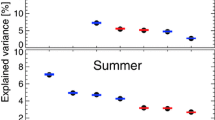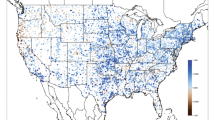Abstract
The Meiyu-Baiu front (MBF) is the primary weather system modulating the monsoonal rainfall in East Asia, and it exhibits pronounced variability across multiple temporal and spatial scales. A suite of new objective indices based upon daily reanalysis data are developed to characterize such variability, which include an “intensity” index effectively measuring the meridional gradient of equivalent potential temperature across the frontal zone, a “location” index documenting the central latitude and longitude of the front, and a “stationarity” index corresponding to the standard deviation of the daily central latitude. All these indices are characterized by strong interannual to interdecadal variations. Specifically, the MBF has shown a tendency of southwestward shift since the mid-1990s and become more stationary over southern China with reduced intraseasonal meandering. The western North Pacific subtropical high (WNPSH) is the main circulation feature affecting the location of the MBF on interannual timescales. The MBF moves northward (southward) when the WNPSH is anomalously strong (weak) and the surface high over the region of 35°–50°N/100°–120°E is anomalously weak (strong). When the WNPSH is strong, the MBF is often situated northwest to its climatological position and becomes more stationary. On interdecadal timescales, enhanced activity of high latitude blocking over East Asia is often accompanied with a stronger but less stationary MBF while a negative phase of the Arctic Oscillation favors a southward-shifted and more stationary MBF.










Similar content being viewed by others
References
Akiyama T (1975) Southerly transversal moisture flux into the extremely intense rainfall zone in the Baiu season. J Meteorol Soc Jpn 53:304–316
Chang CP, Zhang Y, Li T (2000) Interannual and interdecadal variations of the East Asian summer monsoon and tropical Pacific SSTs. Part I: roles of the subtropical ridge. J Clim 13:4310–4325
Chen G TJ (1983) Observational aspects of the Mei-Yu phenomena in subtropical China. J Meteorol Soc Jpn 61:306–312
Chen G TJ (2004) Research on the phenomena of Meiyu during the past quarter century: an overview. In: Chang CP (ed) The East Asian monsoon. World Scientific, Singapore, pp 357–403
Chen G TJ, Chang CP (1980) The structure and vorticity budget of an early summer monsoon trough (Mei-Yu) over southeastern China and Japan. Mon Weather Rev 108:942–953
Dee DP et al (2011) The ERA-Interim reanalysis: configuration and performance of the data assimilation system. Q J R meteorol Soc137:553–597
Ding YH (1991) Monsoon over China. Kluwer, Dordrecht, p 419
Ding YH, Chan J CL (2005) The East Asian summer monsoon: an overview. Meteorol Atmos Phys 89:117–142
Ding YH, Liu Y (2001) Onset and the evolution of the summer monsoon over the South China Sea during SCSMEX field experiment in 1998. J Meteorol Soc Jpn 79:255–276
Ding YH, Wang Z, Sun Y (2008) Inter-decadal variation of the summer precipitation in East China and its association with decreasing Asian summer monsoon. Part I: observed evidences. Int J Climatol 28:1139–1161
Gao H, Yang S, Kumar A, Hu Z, Huang B, Li Y, Jha B (2011) Variations of the East Asian Mei-Yu and simulation and prediction by the NCEP climate forecast system. J Clim 24:94–108
Gong DY (2007) Climate of China. In: Wang SW, Li W (eds) Climate disasters. China Meterology Press, Beijing, pp 138–176
Gong DY, Ho CH (2003) Arctic oscillation signals in the East Asian summer monsoon. J Geophys Res 108:4066. doi:10.1029/2002JD002193D2
Huang RH, Wu Y (1989) The influence of ENSO on the summer climate change in China and its mechanism. Adv Atmos Sci 6:21–32
Huang RH, Chen J, Huang G (2007) Characteristics and variations of the East Asian monsoon system and its impacts on climate disasters in China. Adv Atmos Sci 24:993–1023
Lau KM, Kim KM, Yang S (2000) Dynamical and boundary forcing characteristics of regional components of the Asian summer monsoon. J Clim 13:2461–2482
Lejenas H, Okland H (1983) Characteristics of Northern Hemisphere blocking as determined from a long time series of observational data. Tellus 35A:350–362
Matsumoto S, Yoshizumi S, Takeeuchi M (1970) On the structure of the Baiu front and associated intermediate-scale disturbances in the lower atmosphere. J Meteorol Soc Jpn 48:479–491
Ninomiya K (2004) Large- and mesoscale features of Meiyu-Baiu front associated with intense rainfalls. In: Chang CP (ed) East Asian monsoon. World Scientific, Singapore, pp 404–435
Ninomiya K, Shibagaki Y (2007) Multi-scale features of the Meiyu-Baiu front and associated precipitation systems. J Meteorol Soc Jpn 58B:103–122
Saito N (1985) Quasi-stationary waves in mid-latitudes and the Baiu in Japan. J Meteorol Soc Jpn 63:983–995
Sample T, Xie XP (2010) Large-scale dynamics of the Meiyu-Baiu rainband: environmental forcing by the westerly jet. J Clim 23:113–132
Shen S, Lau KM (1995) Biennial oscillation associated with the East Asian monsoon and tropical sea surface temperatures. J Meteorol Soc Jpn 73:105–124
Tanaka M (1997) Interannual and interdecadal variations of the western north Pacific monsoon and Baiu rainfall and their relationship to the ENSO cycles. J Meteorol Soc Japan 75:1109–1123
Tao S, Chen L (1987) A review of recent research on the East Asia summer monsoon over China. In: Chang CP, Krishnamurti TN (eds) Monsoon meteorology. Oxford University Press, Oxford, pp 50–92
Tibaldi S, Molteni F (1990) On the operational predictability of blocking. Tellus 42A:343–365
Wang Y (1992) Effects of blocking anticyclones in Eurasia in the rainy season Meiyu/Baiu season. J Meteorol Soc Jpn 70:929–950
Wang B, Fan Z (1999) Choice of South Asian summer monsoon indices. Bull Am Meteorol Soc 80:629–638
Wang B, LinHo (2002) Rainy season of the Asian–Pacific summer monsoon. J Clim 15:386–398
Wang J, Tao S (2002) Structure and formation of Mei-yu front in 1998. J Appl Meteorol Sci 13:526–534 (Chinese with English abstract)
Wang Y, Zhou L (2005) Observed trends in extreme precipitation events in China during 1961–2001 and the associated changes in large-scale circulation. Geophys Res Lett 32:L09707. doi:10.1029/2005GL022574
Wang Z, Ding Y, Lu M, Zhou B, Yang S, Jiang X, Ke Z (2017) Intraseasonal variability and predictability of the subtropical Asian summer rain band. Int J Climatol. doi:10.1002/joc.5033
Wu B, Zhou T (2008) Oceanic origin of the interannual and interdecadal variability of the summertime western Pacific subtropical high. Geophys Res Lett 35:L13701. doi:10.1029/2008GL034584
Xu M, Xu H, Ren H (2017) Influence of Kuroshio SST front in the East China Sea on the climatological evolution of Meiyu rainband. Clim Dyn. doi:10.1007/s00382-017-3681-2
Yang F, Lau KM (2004) Trend and variability of China precipitation in spring and summer: linkage to sea-surface temperatures. Int J Climatol 24:1625–1644
Zhang X, Tao S, Zhang Q (2002) Structures of Meiyu fronts in 1998. Q J Appl Meteorol Sci 13:258–268
Zhou Y, Guo S, Shen S SP (2004) A diagnostic study of formation and structure of the Meiyu front system over East Asia. J Meteorol Soc Jpn 82:1565–1576
Zhou T, Gong D, Li J, Li B (2009a) Detecting and understanding the multi-decadal variability of the East Asian summer monsoon—recent progress and state of affairs. Meteorol Z 18:455–467
Zhou T, Yu R, Zhang J, Drange H, Cassou C, Deser C, Hodson D LR, Sanchez-Gomez E, Li J, Keenlyside N, Xin X, Okumura Y (2009b) Why the western Pacific subtropical high has extended westward since the late 1970s. J Clim 22:2199–2215
Zhu C, Nakazawa T, Li J, Chen L (2003) The 30–60 day intraseasonal oscillation over the western North Pacific Ocean and its impacts on summer flooding in China during 1998. Geophys Res Lett 30. doi:10.1029/2003GL017817
Acknowledgements
The observational data used in this study are from the NOAA CPC (http://www.esrl.noaa.gov/psd/data/gridded/data.unified.html), NCEP-NCAR reanalysis (http://www.esrl.noaa.gov/psd/data/gridded/data.ncep.reanalysis.html), and European Centre for Medium-range Weather Forecasts (https://www.ecmwf.int/en/research/climate-reanalysis/era-interim). Yi Deng and Henian Zhang are supported by the National Science Foundation Climate and Large-Scale Dynamics (CLD) program through grants AGS-1354402 and AGS-1445956. This study is also supported by the National Key Scientific Research Plan of China (Grant 2014CB953900), the National Natural Science Foundation of China (Grant 41661144019), the LASW State Key Laboratory Special Fund (2016LASW-B01), the “111-Plan” Project of China (Grant B17049), and the Guangzhou Joint Research Center for Atmospheric Sciences of CMA.
Author information
Authors and Affiliations
Corresponding authors
Rights and permissions
About this article
Cite this article
Li, Y., Deng, Y., Yang, S. et al. Multi-scale temporospatial variability of the East Asian Meiyu-Baiu fronts: characterization with a suite of new objective indices. Clim Dyn 51, 1659–1670 (2018). https://doi.org/10.1007/s00382-017-3975-4
Received:
Accepted:
Published:
Issue Date:
DOI: https://doi.org/10.1007/s00382-017-3975-4




